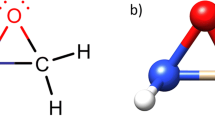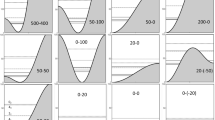A Recursion relations at work
We show here how the recursion relations presented in Refs. [7] and [4] can be used to generate the E coefficients to arbitrarily high quantum numbers. The starting point for these relations is \(E[0,0,0,0,0,0,0,0,0]=1\). Then, the recursion relations are used to generate the coefficients in the following order, where the bold quantum numbers indicate the ones being increased:
$$\begin{aligned}&(1) \ E[n,\mathbf{l },\mathbf{l },\tilde{n},0,0,t,u,v] \quad (2) \ E[n,0,0,\tilde{n},\tilde{\mathbf{l }},\tilde{\mathbf{l }},t,u,v]\\&(3) \ E[n,\mathbf{l },\mathbf{l },\tilde{n},\tilde{l},\tilde{l},t,u,v] \quad (4)\ E[n,\mathbf{l },0,\tilde{n},0,0,t,u,v] \\&(5)\ E[n,0,0,\tilde{n},\tilde{\mathbf{l }},0,t,u,v] \quad (6) \ E[n,\mathbf{l },0,\tilde{n},\tilde{l},0,t,u,v] \\&(7) \ E[n,\mathbf{l },\mathbf{l },\tilde{n},\tilde{l},0,t,u,v] \quad (8) \ E[n,0,0,\tilde{n},\tilde{\mathbf{l }},\tilde{\mathbf{m }},t,u,v]\\&(9) \ E[n,\mathbf{l },0,\tilde{n},\tilde{l},\tilde{m},t,u,v] \quad (10) \ E[n,\mathbf{l },\mathbf{l },\tilde{n},\tilde{l},\tilde{m},t,u,v] \\&(11) \ E[n,\mathbf{l },\mathbf{m },\tilde{n},\tilde{l},0,t,u,v] \quad (12) \ E[n,\mathbf{l },0,\tilde{n},\tilde{l},\tilde{l},t,u,v] \\&(13) \ E[n,\mathbf{l },\mathbf{m },\tilde{n},\tilde{l},\tilde{l},t,u,v] \quad (14) \ E[n,\mathbf{l },\mathbf{m },\tilde{n},\tilde{l},\tilde{m},t,u,v]\\&(15) \ E[\mathbf{n },l,m,\tilde{n},\tilde{l},\tilde{m},t,u,v] \quad (16) \ E[n,l,m,\tilde{\mathbf{n }},\tilde{l},\tilde{m},t,u,v] \end{aligned}$$
At each step, the coefficients are generated for all of the \(N^E(l,\tilde{l})\) triplets t, u, v which have potentially nonzero contributions.
B Formulae for analytical force coefficients
The calculation of the \(G_k^K\) coefficients is similar to the procedure described in Appendix A, except that now the coefficients are zero for \(t+u+v > 2n+2\tilde{n}+l+\tilde{l}+1\) and the starting point of the recurrences is as follows [8]:
$$\begin{aligned} G_k^A[0,0,0,0,0,0,0,0,0]&= 2\frac{\alpha \beta }{\gamma }(B_k-A_k) \times \\&\times E[0,0,0,0,0,0,0,0,0] \end{aligned}$$
and
$$\begin{aligned} G_k^A[0,0,0,0,0,0,\delta _{kx},\delta _{ky},\delta _{kz}] = \frac{\alpha }{\gamma }E[0,0,0,0,0,0,0,0,0] \end{aligned}$$
Doll et al. [8] provide formulae for increasing the quantum numbers on center A of the \(G_x^A\); here we provide similar formulae for the \(G_y^A\) and \(G_z^A\) cases as well, which complete the formalism. The quantum numbers n and \(\tilde{n}\) are omitted from the formulae in which they are constant.
1.1 B.1 Recurrence in n
1.1.1 B.1.1 Derivative in y
$$\begin{aligned}&G_y^A[n+1,l,m,\tilde{n},\tilde{l},\tilde{m},t,u,v]\nonumber \\&=\frac{1}{(2\gamma )^2}\bigg ( G_y^A[n,l,m,\tilde{n},\tilde{l},\tilde{m},t-2,u,v]\nonumber \\&\quad +\,G_y^A[n,l,m,\tilde{n},\tilde{l},\tilde{m},t,u-2,v] \nonumber \\&\quad +\, G_y^A[n,l,m,\tilde{n},\tilde{l},\tilde{m},t,u,v-2] \bigg ) \nonumber \\&\quad +\,\frac{1}{\gamma } \bigg ( -E[n,l,m,\tilde{n},\tilde{l},\tilde{m},t,u-1,v] \nonumber \\&\quad +\, (P_x-A_x)G_y^A[n,l,m,\tilde{n},\tilde{l},\tilde{m},t-1,u,v] \nonumber \\&\quad \,+(P_y-A_y)G_y^A[n,l,m,\tilde{n},\tilde{l},\tilde{m},t,u-1,v] \nonumber \\&\quad \,+(P_z-A_z)G_y^A[n,l,m,\tilde{n},\tilde{l},\tilde{m},t,u,v-1] \bigg ) \nonumber \\&\quad +\, \Big ( |\mathbf P -\mathbf A |^2+\frac{1}{\gamma }\big ( t+u+v+\frac{3}{2} \big ) \Big ) \nonumber \\&\quad \times G_y^A[n,l,m,\tilde{n},\tilde{l},\tilde{m},t,u,v] \nonumber \\&\quad -\,2(P_y-A_y)E[n,l,m,\tilde{n},\tilde{l},\tilde{m},t,u,v] \nonumber \\&\quad +\,2(t+1)(P_x-A_x)G_y^A[n,l,m,\tilde{n},\tilde{l},\tilde{m},t+1,u,v] \nonumber \\&\quad +\,2(u+1)(P_y-A_y)G_y^A[n,l,m,\tilde{n},\tilde{l},\tilde{m},t,u+1,v] \nonumber \\&\quad +\,2(v+1)(P_z-A_z)G_y^A[n,l,m,\tilde{n},\tilde{l},\tilde{m},t,u,v+1] \nonumber \\&\quad -\,2(u+1)E[n,l,m,\tilde{n},\tilde{l},\tilde{m},t,u+1,v] \nonumber \\&\quad +\,(t+2)(t+1)G_y^A[n,l,m,\tilde{n},\tilde{l},\tilde{m},t+2,u,v] \nonumber \\&\quad +\,(u+2)(u+1)G_y^A[n,l,m,\tilde{n},\tilde{l},\tilde{m},t,u+2,v] \nonumber \\&\quad +\,(v+2)(v+1)G_y^A[n,l,m,\tilde{n},\tilde{l},\tilde{m},t,u,v+2] \end{aligned}$$
(17)
1.1.2 B 1.2 Derivative in z
$$\begin{aligned}&G_z^A[n+1,l,m,\tilde{n},\tilde{l},\tilde{m},t,u,v]\nonumber \\&=\frac{1}{(2\gamma )^2}\bigg ( G_z^A[n,l,m,\tilde{n},\tilde{l},\tilde{m},t-2,u,v]\nonumber \\&\quad +\,G_z^A[n,l,m,\tilde{n},\tilde{l},\tilde{m},t,u-2,v] \nonumber \\&\quad +\, G_z^A[n,l,m,\tilde{n},\tilde{l},\tilde{m},t,u,v-2] \bigg ) \nonumber \\&\quad +\,\frac{1}{\gamma } \bigg ( -E[n,l,m,\tilde{n},\tilde{l},\tilde{m},t,u,v-1] \nonumber \\&\quad +\, (P_x-A_x)G_z^A[n,l,m,\tilde{n},\tilde{l},\tilde{m},t-1,u,v] \nonumber \\&\quad +\,(P_y-A_y)G_z^A[n,l,m,\tilde{n},\tilde{l},\tilde{m},t,u-1,v] \nonumber \\&\quad +\,(P_z-A_z)G_z^A[n,l,m,\tilde{n},\tilde{l},\tilde{m},t,u,v-1] \bigg ) \nonumber \\&\quad +\, \left( |\mathbf P -\mathbf A |^2+\frac{1}{\gamma }\big ( t+u+v+\frac{3}{2} \big ) \right) \nonumber \\&\quad \times G_z^A[n,l,m,\tilde{n},\tilde{l},\tilde{m},t,u,v] \nonumber \\&\quad -\,2(P_z-A_z)E[n,l,m,\tilde{n},\tilde{l},\tilde{m},t,u,v] \nonumber \\&\quad +\,2(t+1)(P_x-A_x)G_z^A[n,l,m,\tilde{n},\tilde{l},\tilde{m},t+1,u,v] \nonumber \\&\quad +\,2(u+1)(P_y-A_y)G_z^A[n,l,m,\tilde{n},\tilde{l},\tilde{m},t,u+1,v] \nonumber \\&\quad +\,2(v+1)(P_z-A_z)G_z^A[n,l,m,\tilde{n},\tilde{l},\tilde{m},t,u,v+1] \nonumber \\&\quad -\,2(v+1)E[n,l,m,\tilde{n},\tilde{l},\tilde{m},t,u,v+1] \nonumber \\&\quad +\,(t+2)(t+1)G_z^A[n,l,m,\tilde{n},\tilde{l},\tilde{m},t+2,u,v] \nonumber \\&\quad +\,(u+2)(u+1)G_z^A[n,l,m,\tilde{n},\tilde{l},\tilde{m},t,u+2,v] \nonumber \\&\quad +\,(v+2)(v+1)G_z^A[n,l,m,\tilde{n},\tilde{l},\tilde{m},t,u,v+2] \end{aligned}$$
(18)
1.2 B.2 Recurrence in l and m
1.2.1 B.2.1 Derivative in y
$$\begin{aligned}&G_y^A[l+1,l+1,\tilde{l},\tilde{m},t,u,v]\nonumber \\&=(2l+1)\bigg (-iE[l,l,\tilde{l},\tilde{m},t,u,v] \nonumber \\&\quad +\,\frac{1}{2\gamma }G_y^A[l,l,\tilde{l},\tilde{m},t-1,u,v] \nonumber \\&\quad +\,(t+1)G_y^A[l,l,\tilde{l},\tilde{m},t+1,u,v] \nonumber \\&\quad +\,(P_x-A_x)G_y^A[l,l,\tilde{l},\tilde{m},t,u,v] \nonumber \\&\quad +\,i\frac{1}{2\gamma }G_y^A[l,l,\tilde{l},\tilde{m},t,u-1,v] \nonumber \\&\quad +\,i(u+1)G_y^A[l,l,\tilde{l},\tilde{m},t,u+1,v] \nonumber \\&\quad +\,i(P_y-A_y)G_y^A[l,l,\tilde{l},\tilde{m},t,u,v]\bigg ) \end{aligned}$$
(19)
1.2.2 B.2.2 Derivative in z
$$\begin{aligned}&G_z^A[l+1,l+1,\tilde{l},\tilde{m},t,u,v]\nonumber \\&=(2l+1)\bigg (\frac{1}{2\gamma }G_z^A[l,l,\tilde{l},\tilde{m},t-1,u,v] \nonumber \\&\quad +\,(t+1)G_z^A[l,l,\tilde{l},\tilde{m},t+1,u,v] \nonumber \\&\quad +\,(P_x-A_x)G_z^A[l,l,\tilde{l},\tilde{m},t,u,v] \nonumber \\&\quad +\,i\frac{1}{2\gamma }G_z^A[l,l,\tilde{l},\tilde{m},t,u-1,v] \nonumber \\&\quad +\,i(u+1)G_z^A[l,l,\tilde{l},\tilde{m},t,u+1,v] \nonumber \\&\quad +\,i(P_y-A_y)G_z^A[l,l,\tilde{l},\tilde{m},t,u,v]\bigg ) \end{aligned}$$
(20)
1.3 B.3 Recurrence in l and − m
1.3.1 B.3.1 Derivative in y
$$\begin{aligned}&G_y^A[l+1,-l-1,\tilde{l},\tilde{m},t,u,v] \nonumber \\&=(2l+1)\bigg (iE[l,-l,\tilde{l},\tilde{m},t,u,v] \nonumber \\&\quad +\,\frac{1}{2\gamma }G_y^A[l,-l,\tilde{l},\tilde{m},t-1,u,v] \nonumber \\&\quad +\,(t+1)G_y^A[l,-l,\tilde{l},\tilde{m},t+1,u,v] \nonumber \\&\quad +\,(P_x-A_x)G_y^A[l,-l,\tilde{l},\tilde{m},t,u,v] \nonumber \\&\quad -\,i\frac{1}{2\gamma }G_y^A[l,-l,\tilde{l},\tilde{m},t,u-1,v] \nonumber \\&\quad -\,i(u+1)G_y^A[l,-l,\tilde{l},\tilde{m},t,u+1,v] \nonumber \\&\quad -\,i(P_y-A_y)G_y^A[l,-l,\tilde{l},\tilde{m},t,u,v]\bigg ) \end{aligned}$$
(21)
1.3.2 B.3.2 Derivative in z
$$\begin{aligned}&G_z^A[l+1,-l-1,\tilde{l},\tilde{m},t,u,v] \nonumber \\&=(2l+1)\bigg (\frac{1}{2\gamma }G_z^A[l,-l,\tilde{l},\tilde{m},t-1,u,v] \nonumber \\&\quad +\,(t+1)G_z^A[l,-l,\tilde{l},\tilde{m},t+1,u,v] \nonumber \\&\quad +\,(P_x-A_x)G_z^A[l,-l,\tilde{l},\tilde{m},t,u,v] \nonumber \\&\quad -\,i\frac{1}{2\gamma }G_z^A[l,-l,\tilde{l},\tilde{m},t,u-1,v] \nonumber \\&\quad -\,i(u+1)G_z^A[l,-l,\tilde{l},\tilde{m},t,u+1,v] \nonumber \\&\quad -\,i(P_y-A_y)G_z^A[l,-l,\tilde{l},\tilde{m},t,u,v]\bigg ) \end{aligned}$$
(22)
1.4 B.4 Recurrence in l
1.4.1 B.4.1 Derivative in y
$$\begin{aligned}&G_y^A[l+1,m,\tilde{l},\tilde{m},t,u,v] \nonumber \\&=\frac{(2l+1)}{(l- |m |+1)} \bigg \{ \frac{1}{2\gamma }G_y^A[l,m,\tilde{l},\tilde{m},t,u,v-1] \nonumber \\&\quad +\,(P_z-A_z)G_y^A[l,m,\tilde{l},\tilde{m},t,u,v] \nonumber \\&\quad +\,(v+1)G_y^A[l,m,\tilde{l},\tilde{m},t,u,v+1] \bigg \} \nonumber \\&\quad -\,\frac{(l+|m |)}{(l- |m |+1)} \bigg \{ \frac{1}{(2\gamma )^2}\Big (G_y^A[l-1,m,\tilde{l},\tilde{m},t-2,u,v]\nonumber \\&\quad +\,G_y^A[l-1,m,\tilde{l},\tilde{m},t,u-2,v] \nonumber \\&\quad +\,G_y^A[l-1,m,\tilde{l},\tilde{m},t,u,v-2] \Big ) \nonumber \\&\quad +\,\frac{1}{\gamma } \Big ( (P_x-A_x)G_y^A[l-1,m,\tilde{l},\tilde{m},t-1,u,v] \nonumber \\&\quad -\, E[l-1,m,\tilde{l},\tilde{m},t,u-1,v] \nonumber \\&\quad +\,(P_y-A_y)G_y^A[l-1,m,\tilde{l},\tilde{m},t,u-1,v] \nonumber \\&\quad +\,(P_z-A_z)G_y^A[l-1,m,\tilde{l},\tilde{m},t,u,v-1]\Big ) \nonumber \\&\quad +\,\Big ( |\mathbf P -\mathbf A |^2+\frac{1}{\gamma }\big ( t+u+v+\frac{3}{2} \big ) \Big ) \nonumber \\&\quad \times G_y^A[l-1,m,\tilde{l},\tilde{m},t,u,v] \nonumber \\&\quad -\,2(P_y-A_y)E[l-1,m,\tilde{l},\tilde{m},t,u,v] \nonumber \\&\quad +\,2(t+1)(P_x-A_x)G_y^A[l-1,m,\tilde{l},\tilde{m},t+1,u,v] \nonumber \\&\quad +\,2(u+1)(P_y-A_y)G_y^A[l-1,m,\tilde{l},\tilde{m},t,u+1,v] \nonumber \\&\quad +\,2(v+1)(P_z-A_z)G_y^A[l-1,m,\tilde{l},\tilde{m},t,u,v+1] \nonumber \\&\quad -\,2(u+1)E[l-1,m,\tilde{l},\tilde{m},t,u+1,v] \nonumber \\&\quad +\,(t+2)(t+1)G_y^A[l-1,m,\tilde{l},\tilde{m},t+2,u,v] \nonumber \\&\quad +\,(u+2)(u+1)G_y^A[l-1,m,\tilde{l},\tilde{m},t,u+2,v] \nonumber \\&\quad +\,(v+2)(v+1)G_y^A[l-1,m,\tilde{l},\tilde{m},t,u,v+2] \bigg \} \end{aligned}$$
(23)
1.4.2 B.4.2 Derivative in z
$$\begin{aligned}&G_z^A[l+1,m,\tilde{l},\tilde{m},t,u,v] \nonumber \\&=\frac{(2l+1)}{(l- |m |+1)} \bigg \{ \frac{1}{2\gamma }G_z^A[l,m,\tilde{l},\tilde{m},t,u,v-1] \nonumber \\&\quad -\,E[l,m,\tilde{l},\tilde{m},t,u,v] \nonumber \\&\quad +\,(P_z-A_z)G_z^A[l,m,\tilde{l},\tilde{m},t,u,v] \nonumber \\&\quad +\,(v+1)G_z^A[l,m,\tilde{l},\tilde{m},t,u,v+1] \bigg \} \nonumber \\&\quad -\,\frac{(l+|m |)}{(l- |m |+1)} \bigg \{ \frac{1}{(2\gamma )^2}\Big ( G_z^A[l-1,m,\tilde{l},\tilde{m},t-2,u,v] \nonumber \\&\quad +\,G_z^A[l-1,m,\tilde{l},\tilde{m},t,u-2,v] \nonumber \\&\quad +\,G_z^A[l-1,m,\tilde{l},\tilde{m},t,u,v-2] \Big ) \nonumber \\&\quad +\,\frac{1}{\gamma } \Big ( (P_x-A_x)G_z^A[l-1,m,\tilde{l},\tilde{m},t-1,u,v] \nonumber \\&\quad -\, E[l-1,m,\tilde{l},\tilde{m},t,u,v-1] \nonumber \\&\quad +\,(P_y-A_y)G_z^A[l-1,m,\tilde{l},\tilde{m},t,u-1,v] \nonumber \\&\quad +\,(P_z-A_z)G_z^A[l-1,m,\tilde{l},\tilde{m},t,u,v-1]\Big ) \nonumber \\&\quad +\,\Big ( |\mathbf P -\mathbf A |^2+\frac{1}{\gamma }\big ( t+u+v+\frac{3}{2} \big ) \Big ) \nonumber \\&\quad \times G_z^A[l-1,m,\tilde{l},\tilde{m},t,u,v] \nonumber \\&\quad -\,2(P_z-A_z)E[l-1,m,\tilde{l},\tilde{m},t,u,v] \nonumber \\&\quad +\,2(t+1)(P_x-A_x)G_z^A[l-1,m,\tilde{l},\tilde{m},t+1,u,v] \nonumber \\&\quad +\,2(u+1)(P_y-A_y)G_z^A[l-1,m,\tilde{l},\tilde{m},t,u+1,v] \nonumber \\&\quad +\,2(v+1)(P_z-A_z)G_z^A[l-1,m,\tilde{l},\tilde{m},t,u,v+1] \nonumber \\&\quad -\,2(v+1)E[l-1,m,\tilde{l},\tilde{m},t,u,v+1] \nonumber \\&\quad +\,(t+2)(t+1)G_z^A[l-1,m,\tilde{l},\tilde{m},t+2,u,v] \nonumber \\&\quad +\,(u+2)(u+1)G_z^A[l-1,m,\tilde{l},\tilde{m},t,u+2,v] \nonumber \\&\quad +\,(v+2)(v+1)G_z^A[l-1,m,\tilde{l},\tilde{m},t,u,v+2] \bigg \} \end{aligned}$$
(24)




